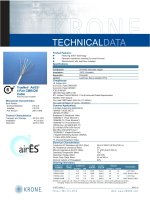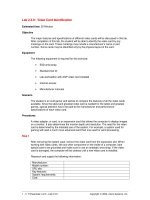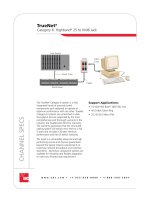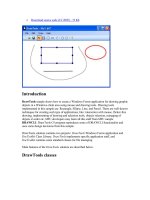Tài liệu DrawTools ppt
Bạn đang xem bản rút gọn của tài liệu. Xem và tải ngay bản đầy đủ của tài liệu tại đây (148.76 KB, 7 trang )
• Download source code (C# 2005) - 72 Kb
Introduction
DrawTools sample shows how to create a Windows Forms application for drawing graphic
objects in a Windows client area using mouse and drawing tools. Drawing tools
implemented in this sample are: Rectangle, Ellipse, Line, and Pencil. There are well-known
techniques for creating such type of applications, like: interaction with mouse, flicker-free
drawing, implementing of drawing and selection tools, objects selection, managing of
objects Z-order etc. MFC developers may learn all this stuff from MFC sample
DRAWCLI. DrawTools C# program reproduces some of DRAWCLI functionality and
uses some design decisions from this sample.
DrawTools solution contains two projects: DrawTools Windows Forms application and
DocToolkit Class Library. DrawTools implements specific application stuff, and
DocToolkit contains some standard classes for file managing.
Main features of the DrawTools solution are described below.
DrawTools classes
• DrawArea - user control which fills main application window client area. Contains
instance of the GraphicsList class. Draws graphic objects, handles mouse input
passing commands to GraphicsList.
• GraphicsList - list of graphic objects. Contains ArrayList of graphic objects.
Talks with each graphic object by generic way using DrawObject methods.
• DrawObject - abstract base class for all graphic objects.
• DrawRectangle - rectangle graphic object.
• DrawEllipise - ellipse graphic object.
• DrawLine - line graphic object.
• DrawPolygon - polygon graphic object.
• Tool - abstract base class for all drawing tools.
• ToolPointer - pointer tool (neutral tool). Contains implementation for selection,
moving, resizing of graphic objects.
• ToolObject - abstract base class for all tools which create new graphic object.
• ToolRectangle - rectangle tool.
• ToolEllipse - ellipse tool.
• ToolLine - line tool.
• ToolPolygon - polygon tool.
DocToolkit Library
DocToolkit Library contains a set of classes which may be used for creation of document-
centric Windows Forms applications. Instances of classes exported from the DocToolkit
Library are kept in the main form of the DrawTools project and is used for general file-
related operations.
• DocManager class: Makes file-related operations: open, new, save, updating of the
form title, registering of file type for Windows Shell. Built using the article
Creating Document-Centric Applications in Windows Forms by Chris Sells.
• DragDropManager class: Allows to open files dropped from Windows Explorer in
Windows Forms applications.
• MruManager class: Manages Most Recently Used Files list.
• PersistWindowState class: Allows to keep last window state in the Registry and
restore it when form is loaded. Source: Saving and Restoring the Location, Size and
Windows State of a .NET Form By Joel Matthias.
Handling of Windows controls state at application idle
time
Every Windows Forms application has a number of controls like menu items, buttons,
toolbar buttons etc. Depending on current situation and user commands, these controls may
have different states: enabled/disabled, checked/unchecked, visible/invisible etc. Every
user action may change this state. Setting of controls' state in every message handler may
be error-prone. Instead of this, it is better to manage controls' state in some function which
is called after every user action. MFC has the great ON_UPDATE_COMMAND_UI feature which
allows to update toolbar buttons' state at application idle time. Such a feature may be
implemented also in .NET programs.
Consider the situation when user clicks the Rectangle toolbar button. This button should be
checked, and previously active tool should be unchecked. Rectangle button message
handler doesn't change form controls' state, it just keeps current selection in some variable.
Idle message handler selects active tool and unselects inactive tool.
Collapse
private void Form1_Load(object sender, System.EventArgs e)
{
// Submit to Idle event to set controls state at idle time
Application.Idle += delegate(object o, EventArgs a)
{
SetStateOfControls();
};
}
public void SetStateOfControls()
{
// Select active tool
tbPointer.Pushed = (drawArea.ActiveTool ==
DrawArea.DrawToolType.Pointer);
tbRectangle.Pushed =
(drawArea.ActiveTool==DrawArea.DrawToolType.Rectangle);
tbEllipse.Pushed = (drawArea.ActiveTool ==
DrawArea.DrawToolType.Ellipse);
tbLine.Pushed = (drawArea.ActiveTool == DrawArea.DrawToolType.Line);
tbPolygon.Pushed = (drawArea.ActiveTool ==
DrawArea.DrawToolType.Polygon);
menuDrawPointer.Checked =
(drawArea.ActiveTool ==
DrawArea.DrawToolType.Pointer);
menuDrawRectangle.Checked =
(drawArea.ActiveTool ==
DrawArea.DrawToolType.Rectangle);
menuDrawEllipse.Checked =
(drawArea.ActiveTool ==
DrawArea.DrawToolType.Ellipse);
menuDrawLine.Checked = (drawArea.ActiveTool ==
DrawArea.DrawToolType.Line);
menuDrawPolygon.Checked =
(drawArea.ActiveTool ==
DrawArea.DrawToolType.Polygon);
// ...
}
// Rectangle tool is selected
private void CommandRectangle()
{
drawArea.ActiveTool = DrawArea.DrawToolType.Rectangle;
}
Hit Test
DrawObject class has virtual HitTest function which detects whether a point belongs to
graphic object:
Collapse
public virtual int HitTest(Point point)
{
return -1;
}
Derived classes use virtual PointInObject to make hit test. This function is called from
HitTest. DrawRectangle class implements this function by a simple way:
Collapse
protected override bool PointInObject(Point point)
{
return rectangle.Contains(point);
// rectangle is class member of type Rectangle
}
DrawLine implementation of this function is more complicated:
Collapse
protected override bool PointInObject(Point point)
{
GraphicsPath areaPath;
Pen areaPen;
Region areaRegion;
// Create path which contains wide line
// for easy mouse selection
AreaPath = new GraphicsPath();
AreaPen = new Pen(Color.Black, 7);
AreaPath.AddLine(startPoint.X, startPoint.Y, endPoint.X,
endPoint.Y);
// startPoint and EndPoint are class members of type Point
AreaPath.Widen(AreaPen);
// Create region from the path
AreaRegion = new Region(AreaPath);
return AreaRegion.IsVisible(point);
}
DrawPolygon function works by the same way, but AreaPath contains all lines in the
polygon.
Serialization
GraphicList class implements ISerializable interface which allows to make binary
serialization of the class object. DrawObject class has two virtual functions which are
used for serialization:
Collapse
public virtual void SaveToStream(SerializationInfo info, int
orderNumber)
{
// ...
}
public virtual void LoadFromStream(SerializationInfo info, int
orderNumber)
{
// ...
}
These functions are implemented in every derived class. Binary file has the following
format:
Collapse
Number of objects
Type name
Object









